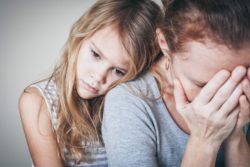Anxiety: How is it Different for Kids and Adults?

Most everyone feels worried and anxious sometimes. This can often be a natural and healthy response to the unknown or a possible danger. Sometimes, however, these feelings of fear and anxiety are so intense and extreme that they hinder one’s ability to function properly within their surroundings. When these feelings escalate to the point that they affect a person’s daily life, an anxiety disorder diagnosis may be appropriate.
Types of Anxiety Disorders
A person’s natural reaction to a possible danger is something called the fight or flight response, a phenomenon that causes their heartrate to rise and breathing to increase, along with other neurological and physical signs. This worry over a perceived danger is not always considered a disorder. It is called a disorder when the excessive fear is so paralyzing that it stops an individual from being able to live life normally. Anxiety disorders can take many forms:
- Phobias
- Separation Anxiety Disorder
- Social Anxiety Disorder
- Post-Traumatic Stress Disorder (PTSD)
- Panic Disorder
- Obsessive-Compulsive Disorder (OCD)
- Generalized Anxiety Disorder
Anxiety disorders can develop at any age; however, there are some differences in symptoms and types of disorders in children versus adults. Learn more about the similarities and differences in anxiety disorders in children and adults. Additionally, some types of anxiety disorders are more prevalent at different ages.
Anxiety in Children
Children cannot process their world in the ways that adults can because their cognitive functioning isn’t fully developed. This affects the way their minds identify and respond to potential threats. This means they often do not realize when their fear reactions become irrational or pervasive; they know only what they are feeling.
Aside from the inability to communicate anxiety, symptoms of anxiety disorders can differ in children. Signs of an anxiety disorder in a child can include several different symptoms, such as:
- Frequent nightmares and disturbed sleep
- Constant restlessness
- Sleepiness or falling asleep in school
- Difficulty concentrating
- Irritability
- Crying, tantrums
Separation anxiety disorder is usually more common in children than adults, as they are transitioning from dependence on their parents to being self-sufficient individuals. Note, however, that the current version of The Diagnostic and Statistical Manual of Mental Disorders (DSM) no longer classifies separation anxiety as only a childhood disorder. This means that it can be diagnosed in children or adults.
Anxiety in Adults
Perhaps the biggest difference in anxiety in children and adults is the ability to recognize and express anxiety. Children have a more difficult time vocalizing their feelings, while adults are able to verbally acknowledge that they are anxious. Because adults’ brains are more fully developed, it may be easier for adults to recognize that their fears may be irrational.
While one can develop any type of anxiety disorder at any age, it’s more common for adults to be diagnosed with phobias, panic disorders, and generalized anxiety disorders. One anxiety disorder common in young adults and teenagers that may not be present in children is social anxiety disorder.
Symptoms of anxiety in adults that are less frequent in children include tense muscles and stomachaches. An adult may also turn to drugs or alcohol as coping mechanisms, which is less likely in young children.
The DSM-5 also utilizes different criteria for diagnosing anxiety disorders in children versus adults. For example, children only need to show one symptom to be diagnosed with generalized anxiety disorder, whereas adults need at least three for a diagnosis.
Similarities in Symptoms
Anxiety disorder symptoms in adults are not always different from those experienced by children. There are many symptoms that are similar for both young children and adults:
- Trouble sleeping
- Lack of focus
- Cold sweats
- Dizziness
- Chest pains
- Nausea
- Shortness of breath
- Irregular heartbeats (i.e. palpitations)
- Feelings of uneasiness, restlessness, panic or terror
For more information about anxiety, coping mechanisms for managing anxiety, and other mental health questions, visit the Mental Health section of our blog. If you or someone you know is in need of treatment for anxiety, learn more about our mental health outpatient programs for adults and adolescents.

